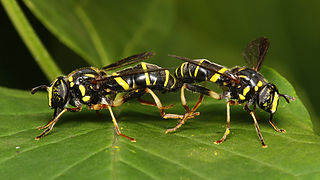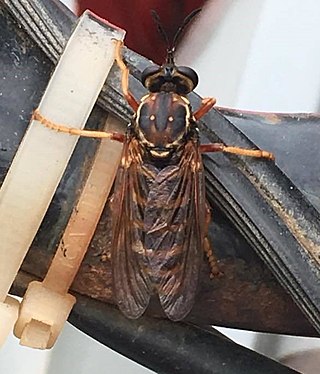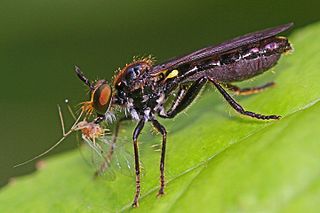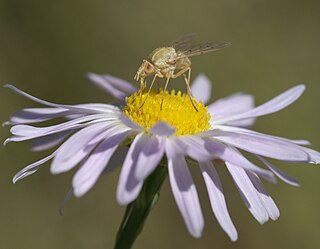
Conopini is a tribe of the flies family Conopidae. The larvae of species are parasitic on bees, especially bumblebees. Most adults will feed on nectar.

Spilomyia is a genus of hoverflies. Many species in the genus show Batesian mimicry of wasp models, including black and yellow patterns and modified antenna shape.

Myopa is a genus of flies from the family Conopidae.

Physocephala is a genus of flies from the family Conopidae.

Thecophora is a genus of thick-headed fly from the family Conopidae.

Zodion is a large genus of flies from the family Conopidae.
Homaluroides is a genus of grass flies in the family Chloropidae. There are about 9 described species in Homaluroides.

Neoascia is a genus of small black and yellow or mostly black flies with a narrow abdomen near the thorax. They occur mainly in damp places among low herbage. The larva of Neosascia are flattened without oral hooks and a have a short posterior spiracular process or "tail" rat-tailed that is saprophagous. In 1925 Curran reviewed the genus Neoascia. In this work a key is provided and ten species are described including four new species some of which have later been determined to be synonyms.

Laphria is a genus described by Johann Wilhelm Meigen in 1803, belonging to the family Asilidae, subfamily Laphriinae. Members of this genus are known as bee-like robber flies. This genus has a Holarctic distribution, occurring in Europe, Asia, and North America. They prey on a variety of insects, including other robber flies, bees, wasps and beetles. Like other asilids, they use their proboscis to penetrate the body of their prey and inject enzymes which dissolve the tissues.
Physoconops bulbirostris is a species in the family Conopidae, in the order Diptera ("flies").
Milesiina is a subtribe of syrphid flies in the family Syrphidae. There are at least 14 described species in Milesiina.

Proctacanthus is a genus of robber flies. There are about 18 described species in Proctacanthus.

Ceraturgus is a genus of robber flies in the family Asilidae. There are about 11 described species in Ceraturgus.

Systropus is a genus of bee flies. There are about 16 described species in Systropus.
Ospriocerus is a genus of robber flies. There are about 17 described species in Ospriocerus.
Nicocles is a genus of robber flies in the family Asilidae. There are about 15 described species in Nicocles.

Eudioctria is a genus of robber flies in the family Asilidae. There are about 14 described species in Eudioctria.

Poecilognathus is a genus of bee flies. There are at least 20 described species in Poecilognathus.
Triploechus is a genus of bee flies, insects in the family Bombyliidae. There are about 10 described species in Triploechus.
Brontaea is a genus of house flies, insects in the family Muscidae. There are about five described species in Brontaea.













